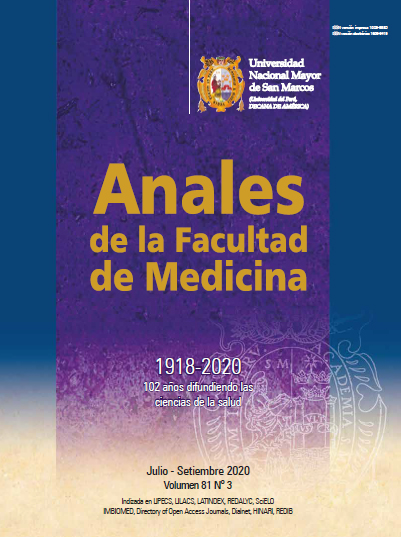Riesgo cardiovascular en una población escolar con exceso de peso
DOI:
https://doi.org/10.15381/anales.v81i3.19603Palabras clave:
Sobrepeso, Obesidad, Medición de riesgo, EscolaresResumen
Objetivo. Determinar factores de riesgo cardiovascular en escolares con exceso de peso y medir su asociación con variables sociodemográficas. Métodos. Estudio transversal, analítico. Se encuestó a 2001 escolares mujeres de 6 a 17 años de un Centro Educativo de Lima Metropolitana. Se utilizó el índice de masa corporal para el diagnóstico de exceso de peso (sobrepeso entre 85 y 95p y obesidad ≥ 95p) y la circunferencia de cintura para obesidad abdominal (≥ 90p). HOMA-I para la resistencia a la insulina (RI) (≥ 3,16) y para las alteraciones lipídicas: colesterol total (≥ 200 mg/dL), C-HDL bajo (≤ 40 mg/dL), C-LDL alto (≥ 130 mg/dL), C no HDL (≥ 145 mg/dL) y triglicéridos (≥ 100 y 130 mg/dL) para niñas menores de 9 y de 10 a 19 años, respectivamente. Resultados. El exceso de peso se presentó mayormente en las escolares de 10 a 17 años, en las que nacieron con más de 2500 gr, con más de un antecedente familiar, con lactancia materna exclusiva y en aquellas cuyas madres no tuvieron instrucción. Las alteraciones lipídicas más frecuentes fueron hipertrigliceridemia y C-HDL bajo. El 82% presentó dislipidemia y el 55,4% de obesos RI. La obesidad abdominal estuvo asociada con los antecedentes familiares y la instrucción de la madre. Conclusion. Cuatro de cada cinco niñas con exceso de peso presentó por lo menos una alteración de los lípidos. Una de cada dos obesas tuvo RI.
Descargas
Publicado
Número
Sección
Licencia
Derechos de autor 2020 Anales de la Facultad de Medicina

Esta obra está bajo una licencia internacional Creative Commons Atribución-NoComercial-CompartirIgual 4.0.
Aquellos autores/as que tengan publicaciones con esta revista, aceptan los términos siguientes:
- Los autores/as conservarán sus derechos de autor y garantizarán a la revista el derecho de primera publicación de su obra, el cuál estará simultáneamente sujeto a la Licencia de reconocimiento de Creative Commons que permite a terceros compartir la obra siempre que se indique su autor y su primera publicación esta revista.
- Los autores/as podrán adoptar otros acuerdos de licencia no exclusiva de distribución de la versión de la obra publicada (p. ej.: depositarla en un archivo telemático institucional o publicarla en un volumen monográfico) siempre que se indique la publicación inicial en esta revista.
- Se permite y recomienda a los autores/as difundir su obra a través de Internet (p. ej.: en archivos telemáticos institucionales o en su página web) antes y durante el proceso de envío, lo cual puede producir intercambios interesantes y aumentar las citas de la obra publicada. (Véase El efecto del acceso abierto).



